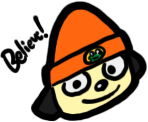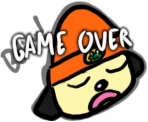As a Sega fan, I tend to have a longer history with Sega games and consoles. Even so, that never stopped me from playing other games "on the other side of the fence".
Since people have been asking me to review some good Playstation games over on deviantArt, I decided to give it a shot with an all-time classic...
From NanaOn-Sha/Sony
Played on PSX
Type Musical game
Year 1996
What is PaRappa the Rapper I hear you ask.
I mean, those of you way too young to have known the phenomenon he became during such a short time.
The game was the breakthrough title developed by NanaOn-Sha.
It's a studio founded by game designer and musician Masaya Matsuurain 1993.
They were also responsible for that other unique music game series Vib-Ribbon. And more recently they collaborated with Zoë Mode on their first adventure game (non-musical) Haunt.
PaRappa Rappa is actually the first "real" modern rhythm game.
It has quite a unique design to it (more on that below), uses animal mascots which were so often the norm for games in the 90s and all songs are in English (as well as the story itself) in all version of the game!
The story is one of the more relatables there is.
What is PaRappa the Rapper I hear you ask.
I mean, those of you way too young to have known the phenomenon he became during such a short time.
The game was the breakthrough title developed by NanaOn-Sha.
It's a studio founded by game designer and musician Masaya Matsuurain 1993.
They were also responsible for that other unique music game series Vib-Ribbon. And more recently they collaborated with Zoë Mode on their first adventure game (non-musical) Haunt.
PaRappa Rappa is actually the first "real" modern rhythm game.
It has quite a unique design to it (more on that below), uses animal mascots which were so often the norm for games in the 90s and all songs are in English (as well as the story itself) in all version of the game!
I gotta believe!~
The story is one of the more relatables there is.
It's the story of a guy, a girl and some problems he learns to deal with (including the local douche bag).
PaRappa is this hip hop dog, you see.
He's in love with Sunny Funny, but she seems to ignore him.. But they're made for each other! If only he could get her to notice him. This egomaniac rich guy Joe Chin is certainly not helping the whole thing.
So PaRappa on his journey to her heart, learns to fight in a dojo, crashes his dad's car, works to get some cash, learns his license, bake a cake, take a bathroom break and ends up rapping on stage.
Throughout this adventure he is accompanied by his pals PJ Berry and Katy Kat. He learns to deal with real life situations through rap with various mentors, including the famous Chop Chop Master Onion.
The game is almost educational, inspirational I want to say.
PaRappa raps through all situations, you'll remember for all time that to drive you need to Step on the gas or also that you need to keep your kitchen in check while cooking Put the cake in the oven for a while! Leave it there, come on, clean the pile!
PaRappa's motto is "I Gotta Believe!" afterall.
There might be this Joe Chin in his path, but things will work out in the end as long as he stays positive and focused!
The game plays like a digital "Simon Sez".
Basically said, the gameplay consists of QTE sequences you need to memorize/answer to.
For example the first stage will assign X for kick and SQUARE for punch.
By pushing the correct buttons as indicated. The music will keep you in tempo, you need to have both the correct action and follow the rythm to work through the various segments.
The game starts easy enough but will quickly get more and more challenging both in the sequences as well as the timing.
You win points for style, if you do good you will keep your U rappin' GOOD ranking. Missing notes/vocals will make it go off, for BAD and AWFUL (and Game over!).
Once the levels are finished you can replay them, go freestyle to deviate into the COOL rating!
The game isn't all perfect though, there's some missync problems and the difficulty is quite hardcore (you need to be perfect sometimes, and learn the darn' buttons perfectly).
The game isn't very long though. It's only six stages long.
Maybe a bit short if you ask me, but it's pure arcade fun!
There are four teachers, so therefore there are 5 styles of rapping.
PaRappa is quite the boss, perfectly able to adapt to various styles, from reggae to pop, house and even some old school!
The music is simply catchy, memorable!
The characters look all great and just as memorable.
The art style was done by Rodney Greenblat (check out his website!), an US graphic artist who's quite popular in Japan.
The characters are all done in flat 2D, which contrasts great with the 3D world they inhabit. The population seems to feature so many random faces from cartoon dogs, cartoon frogs, even cartoon objects such as hammers, flowers, etc.
The game is just pure fun!
Well-written, acted and sung. Excellent voice acting all around.
PaRappa is this hip hop dog, you see.
He's in love with Sunny Funny, but she seems to ignore him.. But they're made for each other! If only he could get her to notice him. This egomaniac rich guy Joe Chin is certainly not helping the whole thing.
So PaRappa on his journey to her heart, learns to fight in a dojo, crashes his dad's car, works to get some cash, learns his license, bake a cake, take a bathroom break and ends up rapping on stage.
Throughout this adventure he is accompanied by his pals PJ Berry and Katy Kat. He learns to deal with real life situations through rap with various mentors, including the famous Chop Chop Master Onion.
It's all in the mind!~
The game is almost educational, inspirational I want to say.
PaRappa raps through all situations, you'll remember for all time that to drive you need to Step on the gas or also that you need to keep your kitchen in check while cooking Put the cake in the oven for a while! Leave it there, come on, clean the pile!
PaRappa's motto is "I Gotta Believe!" afterall.
There might be this Joe Chin in his path, but things will work out in the end as long as he stays positive and focused!
The game plays like a digital "Simon Sez".
Basically said, the gameplay consists of QTE sequences you need to memorize/answer to.
For example the first stage will assign X for kick and SQUARE for punch.
By pushing the correct buttons as indicated. The music will keep you in tempo, you need to have both the correct action and follow the rythm to work through the various segments.
The game starts easy enough but will quickly get more and more challenging both in the sequences as well as the timing.
You win points for style, if you do good you will keep your U rappin' GOOD ranking. Missing notes/vocals will make it go off, for BAD and AWFUL (and Game over!).
Once the levels are finished you can replay them, go freestyle to deviate into the COOL rating!
The game isn't all perfect though, there's some missync problems and the difficulty is quite hardcore (you need to be perfect sometimes, and learn the darn' buttons perfectly).
I need to go, just bad as you!~
The game isn't very long though. It's only six stages long.
Maybe a bit short if you ask me, but it's pure arcade fun!
There are four teachers, so therefore there are 5 styles of rapping.
PaRappa is quite the boss, perfectly able to adapt to various styles, from reggae to pop, house and even some old school!
The music is simply catchy, memorable!
The characters look all great and just as memorable.
The art style was done by Rodney Greenblat (check out his website!), an US graphic artist who's quite popular in Japan.
The characters are all done in flat 2D, which contrasts great with the 3D world they inhabit. The population seems to feature so many random faces from cartoon dogs, cartoon frogs, even cartoon objects such as hammers, flowers, etc.
The game is just pure fun!
Well-written, acted and sung. Excellent voice acting all around.
The gameplay is simple.
Featuring stunning graphics, which I find timeless thanks to the mix 2D/3D.
You can replay the game over and over. Once it's over you can either aim for the high scores, or try getting all the COOL ranks. Which unlock an alternate ending plus a (tiny) bonus song.
Overall, it's a fantastic catchy entertaining game!
A true pioneer of the whole musical genre.
You will love it even if you don't like rap!
It sure was more original than what the genre offers today in the countless dull and generic Rock bands, Guitar hero, Singstars and all of their clones...
6 stages long, hours of fun and replay value thanks to its high quality.
What's not to love about "paper doll" cartoony singing characters!?
A true pioneer of the whole musical genre.
You will love it even if you don't like rap!
It sure was more original than what the genre offers today in the countless dull and generic Rock bands, Guitar hero, Singstars and all of their clones...
6 stages long, hours of fun and replay value thanks to its high quality.
What's not to love about "paper doll" cartoony singing characters!?
I give it:













































































Because when you got a problem, the problems won't get solved by themselves, YOU JUST GOTTA BELIEVE!!
The game became a quick hit back then. It was popular enough to warrant a "guitar"-oriented sequel in 1999, a true sequel in 2002 and even a short lived in 2001.
The 1996 original was released for PSP more recently. (though it didn't had nor fix anything, it's an exact copy of this version)